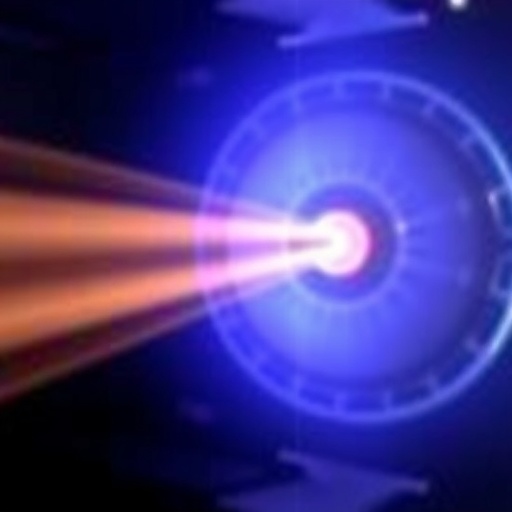In a remarkable stride forward in materials science, researchers from the National University of Singapore (NUS) have unveiled an ultra-clean monolayer amorphous carbon membrane that promises to dramatically enhance the precision and safety of proton therapy for cancer patients. This breakthrough, led by Associate Professor Lu Jiong and his interdisciplinary team, introduces a novel two-dimensional carbon material capable of generating significantly sharper proton beams than existing materials, including graphene and commercial carbon films. The implications of this advancement extend well beyond oncology, potentially revolutionizing fields as diverse as energy storage, catalysis, and next-generation electronics.
The newly developed carbon membrane, named ultra-clean monolayer amorphous carbon (UC-MAC), is exceptional not only for its atomic thinness—just a single atom thick—but also for its unique amorphous structure. Unlike graphene, which is renowned for its perfectly ordered hexagonal carbon rings, UC-MAC is composed of a disordered network of five-, six-, and seven-membered carbon rings. This intrinsic atomic disorder is not a flaw; rather, it is a feature that imparts the membrane with angstrom-scale pores, with dimensions on the order of one ten-billionth of a meter. These pores can be precisely tuned to manipulate subatomic particles such as protons and molecular hydrogen ions (H₂⁺), enabling unprecedented control over particle behavior during filtration and splitting.
This novel pore structure fundamentally transforms how protons interact with the membrane, reducing scattering events that have long plagued proton therapy’s efficacy and safety. Proton therapy depends on the ability to deliver concentrated beams of protons to destroy cancerous tissues precisely while sparing surrounding healthy cells. However, current materials used in the ion source membranes cause considerable proton scattering, diminishing beam sharpness and control. UC-MAC addresses this issue by producing proton beams with twice the sharpness observed with graphene membranes and an astonishing 40-fold reduction in unwanted scattering compared to commercial carbon films, promising far safer and more effective cancer treatments.
A critical challenge in harnessing such advanced materials for practical use lies in their manufacturing. Traditional methods for producing ultra-thin carbon membranes are often lengthy, expensive, and susceptible to contamination by metal impurities, which degrade performance. The NUS research team devised a groundbreaking “disorder-to-disorder” (DTD) synthesis method, which fundamentally shifts the production paradigm. Utilizing inductively coupled plasma chemical vapor deposition (ICP-CVD), they can now fabricate an eight-inch UC-MAC sheet within seconds, free from detectable metal contamination. This industrially compatible, rapid process stands as a milestone in scalable production, bringing this sophisticated material closer to real-world application.
The research effort is notable for its cross-disciplinary collaboration, integrating expertise from synthetic chemistry, materials science, and theoretical physics. Key contributors include Professor Zeng Xiao Cheng from City University of Hong Kong, Assistant Professor Zhao Xiaoxu from Peking University, and Associate Professor Thomas Osipowicz from NUS’s Department of Physics. This diverse expertise was essential for addressing both the complex synthesis challenges and the fundamental understanding of the membrane’s atomic structure and particle filtration properties.
The scientific findings were detailed on July 28, 2025, in the peer-reviewed journal Nature Nanotechnology, cementing the research’s significance within the global scientific community. This high-impact publication signals not only academic recognition but also swells anticipation for practical breakthroughs enabled by UC-MAC.
Beyond the immediate promise in proton therapy, the researchers foresee UC-MAC’s porous, semiconducting structure as a versatile platform for future technologies. It offers compelling potential in energy solutions such as fuel cells and batteries where selective molecular separation and filtration are paramount. Catalysis processes, which depend heavily on precise molecular control, could also greatly benefit from the unique separation capabilities of the material’s angstrom-scale pores. Additionally, the semiconducting properties of UC-MAC might enable ultrathin electronic devices, potentially advancing the development of sub-2-nanometer integrated circuits — critical for sustaining the momentum of Moore’s Law in the coming decades.
This membrane’s extraordinary combination of thinness, cleanliness, and tunability is key to these applications. Its ultra-clean nature, achievable through the metal-free DTD synthesis route, ensures impurities do not interfere with functionality, improving reliability for sensitive uses in medicine and technology. Moreover, the ability to mass-produce large sheets rapidly paves the way for cost-effective fabrication of devices and components incorporating UC-MAC, contrary to the typical slow and costly lab-scale demonstrations of ultra-thin carbon films.
The improvement in proton beam quality demonstrated by UC-MAC is especially transformative for medical treatments. Proton therapy’s non-invasive nature makes it one of the most promising cancer treatment modalities, but its clinical effectiveness has been hampered by imprecise beam control, which can damage healthy tissue and limit radiation doses. The sharper proton beams enabled by UC-MAC membranes could allow clinicians unprecedented control over beam current and directionality, drastically mitigating side effects and enhancing treatment efficacy. This could translate into higher success rates, fewer complications, and better quality of life for cancer patients worldwide.
In conclusion, this innovative ultra-clean monolayer amorphous carbon membrane represents a landmark achievement in material engineering and medical technology. By combining atomic-level disorder with scalable clean manufacturing, the NUS-led team has created a material that not only surpasses graphene’s acclaimed properties but also opens new frontiers for quantum-scale particle manipulation. As subsequent studies and applications emerge, UC-MAC promises to be at the forefront of a new era in precision medicine, energy technology, and miniaturized electronics, embodying a rare fusion of fundamental science and practical impact.
Article Title: Ultraclean monolayer amorphous carbon yields a high-precision proton beam
News Publication Date: 28-Jul-2025
Web References: Nature Nanotechnology article
Image Credits: National University of Singapore
Keywords: Carbon, Protons, Medical treatments




